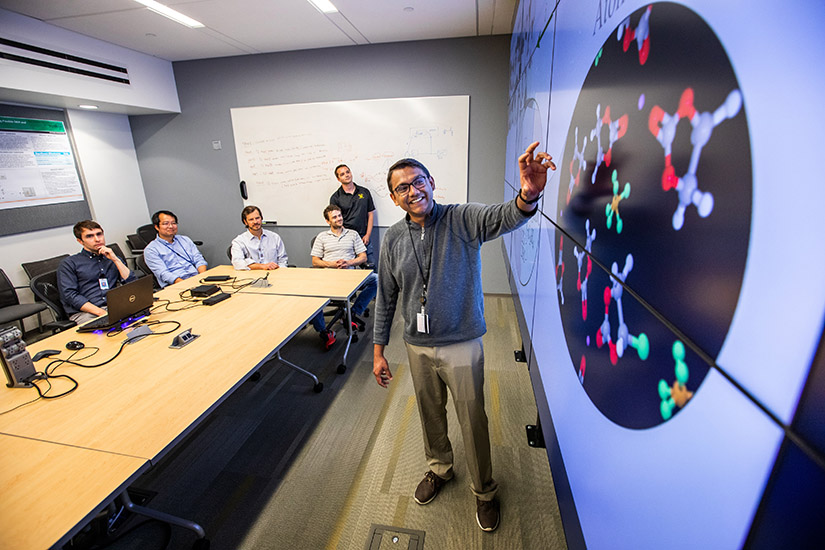Full Speed Ahead: Modeling a Faster Future for Lithium-Ion Batteries

From race car drivers to battery engineers, human nature drives us to push the boundaries of speed, performance, and efficiency in pursuit of excellence. Researchers at the National Renewable Energy Laboratory (NREL) are applying this determination and focus to optimize lithium-ion batteries for faster electric vehicle (EV) charging. While extreme fast charging may not offer the same thrill as extreme sports, faster EV charging provides convenience and flexibility benefits to accelerate the nationwide transition to more sustainable transportation.
For years, researchers have shown that fast charging is possible—the challenge is charging without causing damage to the battery, particularly when the answer may lie in thicker electrode designs for improved vehicle range and reduced battery cost.
Lithium Plating Presents Challenges to Fast-Charge Designs
As batteries charge, lithium ions race from the negative electrode to the positive anode. On arrival, ions insert into graphite particles—a process called intercalation—to store energy. The faster lithium ions move, the faster a battery will charge. However, if you push these ions too hard, they fail to intercalate successfully. In this scenario, lithium forms a dense metallic barrier on the surface of graphite materials, which impedes the movement of lithium ions during charge and discharge. This phenomenon, known as lithium plating, has catastrophic impacts on battery performance, safety, and lifetime.
Over the years, battery researchers have applied numerous techniques to measure and map lithium plating during fast charge. However, existing capabilities are limited by time-consuming or complicated processes, slowing the rate of innovation. To enable faster charging for lithium-ion batteries, researchers need faster characterization methods.
New Process Predicts and Prevents Lithium Plating
Research from the National Renewable Energy Laboratory (NREL) and Lawrence Berkeley National Laboratory, funded by the U.S. Department of Energy’s (DOE’s) eXtreme Fast Charge Cell Evaluation of Lithium-Ion Batteries (XCEL) program, has demonstrated new, more efficient techniques to quantify lithium plating with electrochemical measurements and advanced computer modeling. The innovative approach and in-situ demonstration are detailed in a recent Nature Energy article, “High-Throughput Li Plating Quantification for Fast-Charging Battery Design” (subscription required).
“Our collaborative research explicitly measures how lithium plating changes with electrode thickness, temperature, and charging rates with simple, accessible, and high-throughput cycling techniques,” said Andrew Colclasure, who leads NREL’s battery materials development and modeling research. “Combined with our lab’s physics-based modeling, we refined a new process to predict and prevent lithium plating in future cell designs and charging protocols.”
In addition, researchers used this approach to explore the reversibility of lithium plating and its connection to electrolyte design. These first-of-their-kind measurements found that a significant portion—nearly 70%—of the metallic barrier formed during lithium plating comes off during battery discharge for a standard electrolyte blend. The team found lithium plating reversibility improves significantly as fluoroethylene carbonate is added to the electrolyte. Future battery designs can use this model to simulate the onset and behavior of lithium plating to avoid irreversible lithium consumption.
“These models are the result of over five years of extensive validation and huge amounts of experimental data from our XCEL and industry partners,” Colclasure said. “This research is a great example of the importance of freely shared data and the collaborative power of DOE’s national laboratories.”
Most importantly, the techniques developed as part of this project can be replicated outside of laboratory settings. Part of the excitement surrounding this new approach comes from the accessibility of these methods, which were demonstrated using universal research equipment, Colclasure added.
“As more battery experts across the country measure lithium plating for standard-use battery cells, shared data can help bring the reality of extremely fast battery charging closer to the finish line,” he said.
Learn more about NREL’s energy storage and transportation and mobility research. And sign up for NREL's quarterly transportation and mobility research newsletter, Sustainable Mobility Matters, to stay current on the latest news.
